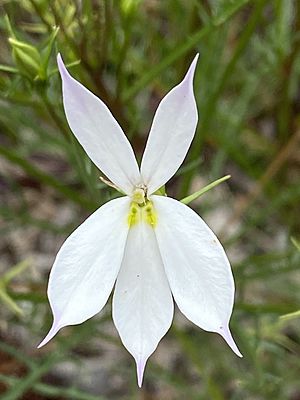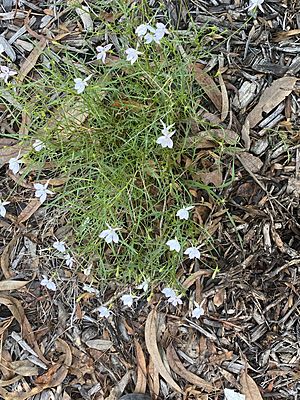Isotoma anethifolia facts for kids
Quick facts for kids Isotoma anethifolia |
|
|---|---|
 |
|
| Scientific classification | |
| Genus: |
Isotoma
|
| Species: |
anethifolia
|
The Isotoma anethifolia is a small, beautiful plant that grows in eastern Australia. It's a type of herb (a plant without a woody stem) and is part of the Campanulaceae family. This plant is endemic to Australia, which means it's found naturally only in that country. It has thin stems and usually white flowers that grow by themselves where the leaves join the stem.
What Does It Look Like?
The Isotoma anethifolia is an upright plant that lives for more than two years (a perennial herb). Its stems are thin and flexible, growing up to about 40 centimeters (16 inches) tall. These stems can be smooth or have short, soft hairs.
The leaves are narrow and shaped like an egg or an oval. They are about 6 to 10 centimeters (2.4 to 3.9 inches) long and 6 to 50 millimeters (0.2 to 2 inches) wide. The edges of the leaves are deeply cut, almost like a feather, into small sections.
The flowers are shaped like stars and are mostly white. They might have a light touch of purple or pink. Each flower grows alone where a leaf meets the stem. The main part of the flower (called the floral tube) is about 10 to 20 millimeters (0.4 to 0.8 inches) long. The flower's petals (called lobes) are pointed and sometimes have small teeth.
Small leaf-like parts called bracts fall off early from the plant. The flower stems (called peduncles) are 4 to 13 centimeters (1.6 to 5.1 inches) long. The green parts that protect the flower bud (called calyx lobes) are 3 to 8 millimeters (0.1 to 0.3 inches) long. After flowering, the plant forms a seed capsule that is shaped like an oval or a cone, about 5 to 17 millimeters (0.2 to 0.7 inches) long. This plant usually blooms in spring and summer.
How It Got Its Name
This plant was officially described for the first time in 1932 by a scientist named Victor Samuel Summerhayes. His description was published in a scientific paper called Bulletin of Miscellaneous Information, Royal Gardens, Kew.
The second part of the plant's scientific name, anethifolia, tells us something about its leaves. It comes from two Latin words: anethum, which means "anise" (a plant with feathery leaves), and folius, which means "leaved." So, anethifolia means "anise-leaved," because its leaves look a bit like those of the anise plant.
Where Does It Grow?
In New South Wales, Australia, you can find this plant growing north of a place called Ebor. It likes to grow in moist, rocky soil that is rich in humus (decaying plant and animal matter). It often grows on areas with granite rock.


